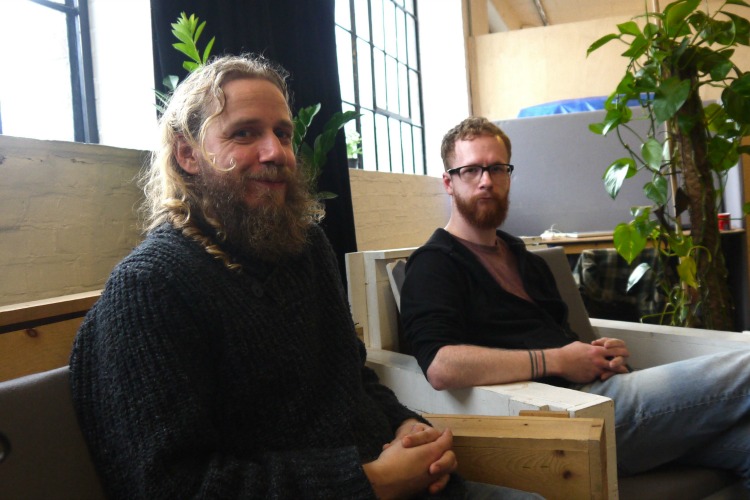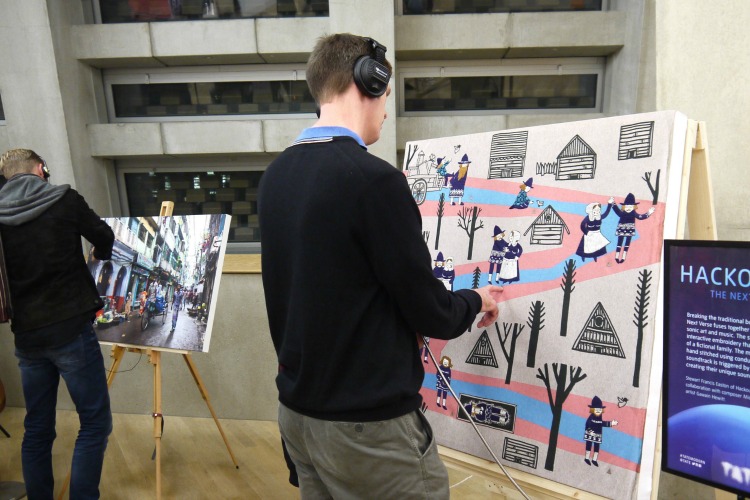Hackoustic, the London network of sound hackers
Published 21 November 2016 by Elsa Ferreira
Hackoustic brings together ten or so sound artists in London. Circuit bending, recycled lute-making or 3D printed records… these maker musicians share their knowledge and exhibit their talents.
London, from our correspondent
Is it art, music or hack? All three replies Tim Yates, founder of the Hackoustic group, a network of sound hackers set up in London. “The limits are completely fluid.”
Trained musician and maker, he co-founded Hackoustic three years ago with the musician artist Saif Bunni to offer “the opportunity and place” to create and distort one’s instruments. “We kind of felt there were a lot of opportunities out there for software hacking or modular synth building but there weren’t many things that were dealing with strings and pieces of wood and the physical side of music making and instrument building,” he explains.

Twice a month, Hackoustic brings together creators with truly different talents who come to present their creations: Kelly Snook, scientist who worked on the Nasa lunar program and develops today Mi.mu, gloves that allow you to control voice and instruments through simple movements of the hand; Opto Noise, musical and artistic project lead by Stan Lewry who plays music by laser projection on mixed medias (records printed in 3D, sugar, plastic, wood,…); Samira Allaouat, aka Night by Night, who created the installation No Plug Sound Machine to create electronic sound without conventional electricity; or still Tom Fox, prolific creator of instruments made of recycled objects who manages the group with Tim Yates. “There is a true need and appetite for a place where people find inspiration and get in contact and have a forum to put stuff out, gain knowledge from the others as well,” says the founder with enthusiasm.
“No Plug Sound Machine”, Night by Night, 2015:
“Bring the right people to the right event”
Hackoustic is neither a collective nor a community. “A group”, they have decided to call themselves, where ten or so musician makers gather (the amplitude is random). Tom Fox and Tim Yates also act as curators and “bring the right people to the right events”. Thus, last October 28, the Tate Modern team made them responsible for finding around ten sound artists for the launch of Uniqlo Tata Late, free monthly event. The Tate Modern obviously appreciates the maker stringed instrument builders since it already called on their services for its inauguration in June.
“It has evolved a lot,” admits Tom Fox. “Because we got offers from these events, maker faire, places that wanted to show off what people had been doing. We wanted to bring people who had been to our presentations to these events because we knew that their work was brilliant and we also wanted to show their work in the place where we were invited.”
On the four floors of the jam packed London modern art museum (more than 14,000 people attended the event), nine makers presented their installations. We saw Tim Yate’s Curio, kind of electronic drum machine that triggers brass percussions, Tom Fox’s instrument collection and his Proximity Mixer, kind of sample installation that triggers samples according to the components touched, the Xoxx composer, elegant sound sample instrument using magnets from the designer Axel Bluhme, or still Stuart Easton’s superb electronic quilts and canvases. A soundtrack composed by Michael Tanner is triggered by a simple brush of the tactile embroidery.

Also a member of the Hackoustic galaxy, Tasos Stamou, electro-acoustic musician who makes most of his instruments from recycled materials, had to pull out of the event on October 28. This adept of circuit bending salvages electronic devices, often old toys, to “convert sound into something more sophisticated”. Even though his music is experimental, the artist from Greek origin has found his public: he has recorded around ten albums and is performing everywhere in Europe. “As an artist, I turned to technique to create new sounds, explains the former photographer. Often, in the hacker world, it’s the opposite.”
Tasos Stamou, “Power Lunches” (edit), Tasos Stamou (Robotribal C42 LAL-80), 2016:
Meeting the general public
Tim Yates feels it: Interest in the sound hacker scene is growing, the Tate exhibition being the latest example, and he intends to take advantage of it. “Most of the time you end up being in a bubble, among sound artists and hackers, which is great. But at the Tate, we reached out to the general public and seeing how people responded to the work shows there really is an interest and an appetite.”
As of next year, both makers would like to organize more “social events” with presentations of projects but also mini workshops to make an instrument with a tube of Pringles for example and “demonstrate that it is very easy to make something”. A way to reach the general public but also to create opportunities for hacker artists. “One of the important things as a group: there are way too many artists working for nothing. One of the things we need to do is to figure out how to make it fair for everyone, the public as well as the artists.”
A complicated mission awaits the leaders of Hackoustic: convert non-initiated people’s ears to experimental music. An initiation in the form of sound journeys, from simple to complex, “almost a collaborative way to approach the vision of a world of sound,” imagines Tim Yates. “If you set off straight away with complicated experiments, people will find it too different. You need to show there is something to discover, that upon entering the room, they are already open to the idea that they will listen to sound like they’ve never heard. You look at the installations, you discover something from the process and when you get to the performance, you are ready to think about sounds differently.”
For more information on Hackoustic and news of its artists
